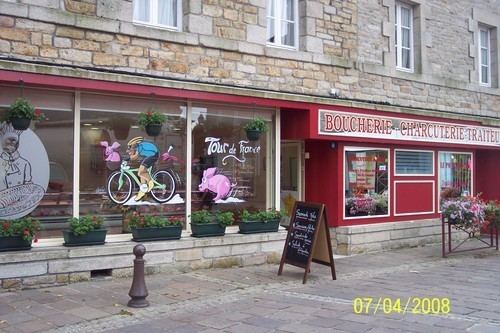Canton Saint-Jean-Brévelay Local time Wednesday 5:21 AM | Area 58.36 km² | |
 | ||
Intercommunality Saint-Jean-Brévelay Communauté Weather 6°C, Wind S at 18 km/h, 97% Humidity | ||
Plumelec ([plymlɛk], Breton: Pluveleg) is a commune in the Morbihan department of the Brittany region, in north-western France.
Contents
- Map of 56420 Plumelec France
- Geography
- Toponymy
- History
- Population and society
- Demography
- Cycling
- Tour de France
- French Road Championship
- French Road Cycling Cup
- Football
- Basketball
- Places and monuments
- Chateaus and manors
- Churches
- Chapels crosses and calvaries
- Other monuments
- Language
- Notable people
- References
Map of 56420 Plumelec, France
The name of its people is Méléciens.
Geography
Plumelec is 95 kilometres (59 mi) west of Rennes via the RN24 road, and 132 kilometres (82 mi) north-west of Nantes via the RN165 road. The commune is situated on the Brittany peninsula and is approximately 10 kilometres (6.2 mi) from the southern coast.
Toponymy
The Plumelec placename is composed of plou (parish) and Melec, patron of Plumelec (possibly Mellitus or Mellit via worship imported from the British Isles).
History
During World War II, on the night of 5–6 June 1944, the SAS team captain Pierre Marienne (9 Free French), responsible for the preparation of Operation Dingson, was accidentally parachuted near Plumelec, 800 metres (2,600 ft) from the la Grée Mill, where there was a German observation post. During the skirmish that ensued, corporal Émile Bouétard was killed: He was the first death of Operation Overlord.
On 12 July 1944 at dawn, 18 resistance fighters were murdered by French collaborators at Kerihuel: Seven paratroopers, eight rebels and three farmers (including Messrs. Alexandre and Rémi Gicquello, father and son, 46 and 18 years old, and Mr. Ferdinand-Mathurin Danet, 49 years). Captain Pierre Marienne, nicknamed the "lion" of Saint Marcel after the battle of 18 June, was one of the victims. Three weeks later, on Sunday 6 August, was the Liberation, American tanks travelled through in the direction of Vannes and Lorient.
In all, there were 42 men from Plumelec and one woman (Ms. Armande Morizur, 35 years), engaged in the Resistance, who gave their lives for the Liberation.
The last survivors of the massacre of Kerihuel have since died: Angèle Guillaume (née Gicquello) died on 2 November 2011, at the age of 81; Roger Danet, son of Ferdinand-Mathurin, died in January 2013; and his brother Augustin Danet, aged 8 years old at the time of the event, died in February 2014.
Population and society
The inhabitants of Plumelec are called in French Méléciens.
Demography
In 2012, the commune had 2,732 inhabitants. The evolution of the number of inhabitants is known through the population censuses carried out in the commune since 1793. From the 21st century, real censuses of communes with less 10,000 population are held every five years, unlike other communes which have a sample survey each year.
Cycling
Many cycling races pass through or arrive by the Côte de Cadoudal, which presents a mean slope of 6.2% at Plumelec and a vertical ascent of 43–154 metres (141–505 ft) over 1.8 kilometres (1.1 mi). This is why the most prestigious cycling races, such as the Tour de France and the French National Road Race Championships, retain Plumelec as a place of passage and arrival.
The commune is also the mainstay of the Grand Prix de Plumelec-Morbihan, a one-day race held since 1974. This is an event which counts towards the French Road Cycling Cup, it has been classified as 1.1 in the UCI Europe Tour since 2005.
Tour de France
French Road Championship
French Road Cycling Cup
Football
Basketball
Places and monuments
The commune contains eight monuments listed in the inventory of historical monuments and two places listed in the general inventory of the cultural heritage.
Chateaus and manors
The town has several chateaus and manors:
Churches
On the territory of the commune, there are three churches:
Of the ancient Church of Saint-Martin, built in the 15th century and demolished in 1890, the municipality maintains a statue representing the Virgin with the child, wooden painted and dated from the 17th century. This statue is filed since 25 March 1924.
Chapels, crosses and calvaries
On the territory of the commune, the Chapel of Saint-Maudé was built in the 15th century, the Chapel of Tolcoetmeur in the 17th century, the Chapel of Notre-Dame-de-Lorette in the 17th century, the Chapels of Callac and Saint-Joseph in the 19th century; as well as several crosses and calvaries:
Other monuments
The well of Touche-Berthelot of the 16th century, located at the way of the cross of Callac has been registered since 14 October 1963. The edge of this has the shape of an octagon with all the prominent angles cornered by pilasters. Four square tiles, placed diagonally to the coping, bear sculptures in high relief with heraldic subjects. They are topped with two crossed arches of wrought iron on which hangs the pulley.
The fountains of Saint-Aubin and Saint-Melec are also present, as are the monument of Kerihuel (12 July 1944 Massacre) and the Cave of Callac (1948, Saint-Joseph).
Language
The commune was Breton-speaking until the 1850s (according to the dictionary of Ogée). Today, people mainly speak French and Gallo. In 1806, according to the survey conducted by Charles Coquebert de Montbret, the commune was also noted as Breton-speaking.
